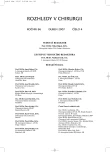Treatment of Gunshot Wounds and Prevention of Complications during the Healing Process
Authors:
E. Jaganjac; T. Kuba; P. Višňa; E. Beitl; J. Kalvach
Authors‘ workplace:
Traumatologické oddělení, Chirurgická klinika UK 2. LF a FN Motol, Praha, přednosta: prof. MUDr. J. Hoch, CSc
Published in:
Rozhl. Chir., 2007, roč. 86, č. 4, s. 188-193.
Category:
Monothematic special - Original
Overview
Introduction:
The objective of the research is the assessment of the way and results of a case-series of treatment of gunshot wounds and to remain of the requirement of complete wound treatment in peace time.
Materials and Methods:
During the period from 1997 to 2006, we treated 60 patients who had penetrating gunshot wounds. The case series included 12 female and 48 male patients ranging in ages from 18 to 71 years (average age 37 years). Weapons that caused injuries included pistol (33), rifle (5), assault rifle AK-47 (1), air gun (9), firecrackers (2), and unknown weapons (10). We assessed outcomes of different therapeutic approaches by monitoring early and late postoperative complications and by total recovery time.
Results:
Two patients died within the first 24 hours; no other patients die after the first 24 hours of initiation of treatment. Thirty-nine patients were hospitalized with hospital stays ranging from 1 to 40 days (average length of stay 13.2 days). Total recovery time varied from 3 to 330 days averaging 65.7 days until full recovery and ability to work.
Fifteen patients had bone injury, eight of which needed osteosyntesis. Four patients received external fixators, two were treated by titanium intramedullar nail, and two by transfixation with Kirchner wire eighteen patients (30%) had secondary sutures. Perioperative complications were osteomyelitis (two patients), pseudoarthrosis of upper extremity proximal phalange (one patient) and non-lethal pulmonary embolism (one patient).
Conclusion:
Standard treatment of penetrating gunshot wounds should consist of primary and prompt detailed debridement, sufficient fasciotomy, and complete drainage of the wound.
Key words:
gunshot wounds – cruciotomy
Sources
1. Westaby, S. Wound Care. Toronto, Canada: St. Louis-Princeton, C. V. Mosby Company, 1986, p. 111–114.
2. Lounsbury, D., Brengman, M., Bellamy, R. Emergency War Surgery. 3rd edition, Borden institute, Walter Reed Army medical center, Washington DC 2004 /on line/, dostupný z : http://www.bordeninstitute.army.mil/emrgncywarsurg/default.html
3. Dragović, M., Todorović, M. Urgentna Iratna Hirurgija. Bělehrad, Serbia: Velarta, 1998, p. 60–64.
4. Banović, D. Traumatologija. Bělehrad, Serbia: Závod za udžbenike i nastavna sredstva, 1998, p. 111–165.
5. Hýkel, J., Malimánek, V. Náboje do ručních palných zbraní. Praha, Česká republika: Naše vojsko Praha, 1998, p. 33.
6. McNab, C. Ruční palné zbraně dvacátého století. Praha, Česká republika: Svojtka Co., 2002, s. 293.
7. Čeramilac, A. Opšta i specijalna patologija mehaničke traume. Zavod za udžbenike i nastavna sredstva, Bělehrad, Serbia: Závod za udžbenike i nastavna sredstva, 1986, p. 80–101.
8. Dozič, Š. Savremeni principi ratne hirurgije u liječenju preloma extremiteta. Sarajevo, Bosna i Hercegovina:, Medicinski bilten. Državna bolnica,1993, p. 21
Labels
Surgery Orthopaedics Trauma surgeryArticle was published in
Perspectives in Surgery

2007 Issue 4
Most read in this issue
- Treatment of Gunshot Wounds and Prevention of Complications during the Healing Process
- Surgical Treatment of Bleeding Gastroduodenal Ulcer
- Acute Intestinal Ischaemia
- Long-term Results after Radical Resections for Pancreatic Ductal Adenocarcinoma – 10 Years Experience
